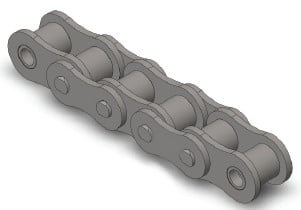Roller chains are a single in the most effective and price eff ective strategies to transmit mechanical power among  shafts. They operate above a broad selection of speeds, deal with massive operating loads, have really little vitality losses and are frequently reasonably priced in contrast with other strategies
shafts. They operate above a broad selection of speeds, deal with massive operating loads, have really little vitality losses and are frequently reasonably priced in contrast with other strategies
of transmitting electrical power. Profitable choice includes following quite a few reasonably basic actions involving algebraic calculation and also the utilization of horsepower and support aspect tables.
For almost any given set of drive ailments, there are a number of attainable chain/sprocket confi gurations which will effectively operate. The designer as a result needs to be mindful of many basic assortment concepts that when applied correctly, assist stability all round drive performance and cost. By following the actions outlined on this segment designers need to be able for making choices that meet the specifications in the drive and are value eff ective.
Standard Roller Chain Drive Concepts
? The encouraged amount of teeth to the tiny sprocket is 15. The minimal is 9 teeth – smoother operation is obtained with more teeth.
? The advisable optimum variety of teeth for that substantial sprocket is 120. Note that even though more teeth lets for smoother operation getting also lots of teeth prospects to chain jumping off the sprocket after a rather smaller volume of chain elongation because of dress in – That is definitely chains by using a extremely significant quantity of teeth accommodate much less dress in just before the chain will no longer wrap all over them appropriately.
? Speed ratios must be 7:one or significantly less (optimum) rather than greater
than ten:1. For more substantial ratios the use of several chain reductions is recommended.
? The advisable minimal wrap of your little sprocket is 120°.
? The advised center distance amongst shafts is 30-50 pitches of chain. You will discover two exceptions to this as follows:
one. The center distance should be higher compared to the sum from the outdoors diameters on the driver and driven sprockets to prevent interference.
two. For speed ratios greater than 3:1 the center distance shouldn’t be significantly less compared to the outside diameter with the substantial sprocket minus the outside diameter of the small sprocket to assure a minimal 120° wrap close to the smaller sprocket.